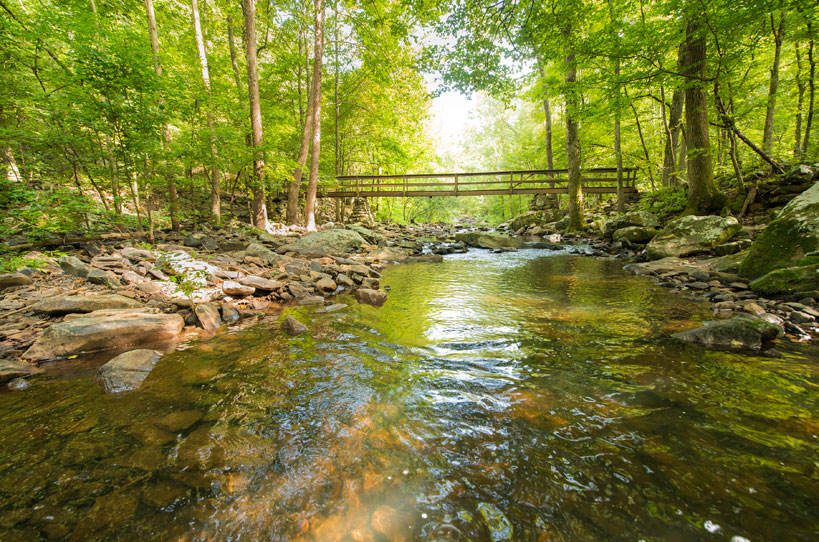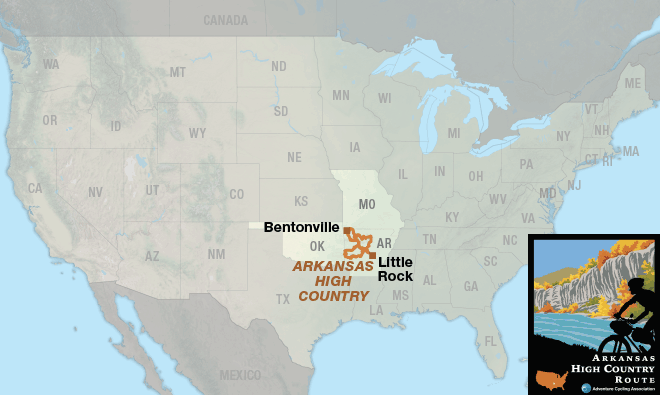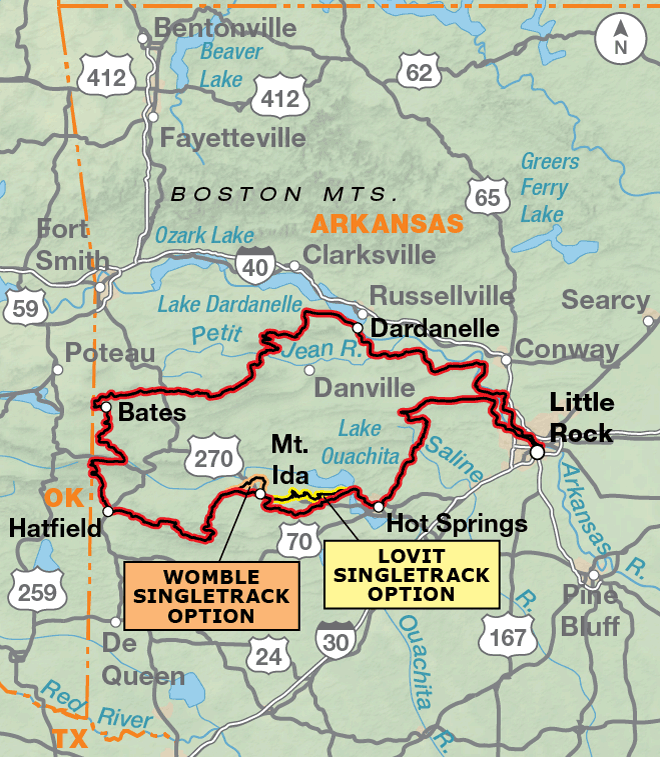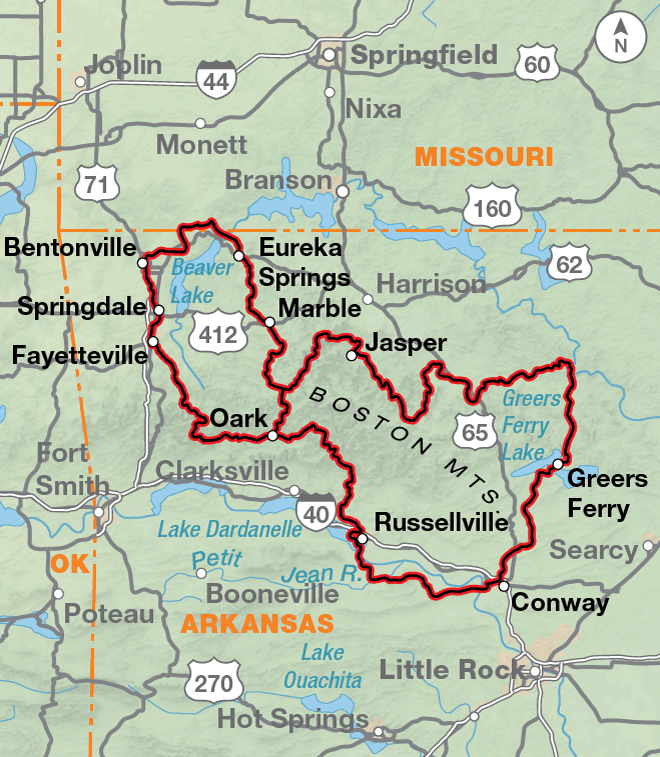Arkansas High Country Route

Get Your Wows in the Ouachitas.
Sparkling streams, hills and hollows, shady rivers, mountain views, waterfalls, swimming holes, historic sites, bustling cities – the Arkansas High Country Route has it all. According to local route designer Chuck Campbell, “That route don’t go no where — It just runs around everywhere!” Indeed, this route is designed to connect many of the interesting places in west-central and northwest Arkansas.

The route is comprised of three large adjacent loops: the South Loop, the Central Loop, and the Northwest Loop. The South Loop, on map section 1, begins and ends in Little Rock. The Northwest and Central Loops, on map section 2, begin and end in Bentonville and Russellville, respectively. A cyclist can choose to ride one or more of the loops, or ride the perimeter of all the loops – it’s up to you.
An additional choice on the South Loop features two singletrack options, using the entire Lake Ouachita Vista Trail (LOViT), and the southern portion of the Womble Trail. Both are International Mountain Bike Association (IMBA) EPIC trails.
Since the routing on the three loops is roughly 50% gravel and 50% pavement, and the climbs/descents can reach gradients between 17 – 21%, choose your bike carefully. Riders who are in a hurry will choose a race geometry gravel bike. Those who choose comfort over speed will elect for full suspension or fat tires to pad the ride. Much of the gravel roads are easily ridden, but there are sections with washboards and cathead boulders. A minimum of 37mm tires with some tread is highly recommended. A wide variety of road conditions exist. National Forest roads can have rough surfaces with loose gravel.
The route passes near multiple designated wilderness areas, including the Flatside, Caney Creek, Upper Kiamichi River, Black Fork Mountain, Poteau Mountain, Dry Creek, Upper Buffalo and Buffalo, and Richland Creek wildernesses. No bikes are permitted in any designated wilderness area.

The Arkansas High Country Route was made possible through the generous support of the Arkansas Parks and Recreation Foundation, with additional support from Adventure Cycling members.
Photo by Arkansas Department of Parks and Tourism
Expect steep hills. Cave Mountain Road climbs 1,900 feet in one mile. Some sections of the route have two or three Category 2 climbs in a 50-mile stretch. The locals will tell you, “If they was to smooth out Newton County, It’d be bigger ‘n Texas.” Many stretches of the route feel like a roller coaster.

The South Loop traverses the Ouachita Mountains and the Arkansas River Valley. In the Ouachitas, the route features sizable climbs and roller coaster ridges. These mountains consist of east to west running ridges and when the route travels east to west, expect to ride a roller coaster across the ridge. Most of the roads in the Ouachitas, except around Hot Springs, are gravel.
The Central Loop traverses the Boston Mountains of the Ozark Plateau, the Buffalo National River corridor, and the Arkansas River Valley. The Arkansas River Valley offers relatively flat terrain and lots of paved roads. The Ozark Mountains are a different story, featuring substantial climbs and roller coaster ridges.
The Northwest Loop climbs and drops between the Springfield Plateau and the Boston Mountains of the Ozark Plateau. Because it is on the Springfield Plateau, the western section of the loop is relatively flat. Even the steep hills are not very tall. The paved Razorback Regional Greenway makes for easy travel. Cycling east on the route the hills increase in size. Climbs become longer where the route moves from Springfield Plateau to the Boston Mountains.
| Arkansas High Country Route - Main Route | ||||
|---|---|---|---|---|
| Section | Distance | Elevation | Total Climb | Avg. Climb/mile |
| Total | 1171.8 miles | Minimum: 220 ft.Maximum:2,650 ft. | 90,720 ft. clockwise90,455 ft. counterclockwise | 77 ft. per mi. clockwise77 ft. per mi. counterclockwise |
| 1 | 500 miles | Minimum: 220 ft.Maximum:2650 ft. | 33,650 ft. clockwise33,460 ft. counterclockwise | 67 ft. per mi. clockwise67 ft. per mi. counterclockwise |
| 2 | 671.8 miles | Minimum: 250 ft.Maximum:2515 ft. | 57,070 ft. clockwise56,995 ft. counterclockwise | 85 ft. per mi. clockwise85 ft. per mi. counterclockwise |
| Arkansas High Country Route - Alternates | ||||
|---|---|---|---|---|
| Name | Section | Distance | Total Climb | Avg. Climb/mi |
| LOViT Singletack | 1 | 46.1 miles | 5,100 ft. clockwise4,700 ft. counterclockwise | 111 ft. per mi. clockwise102 ft. per mi. counterclockwise |
| WOMBLE Singletrack | 1 | 23.1 miles | 2,200 ft. clockwise1,870 ft. counterclockwise | 95 ft. per mi. clockwise81 ft. per mi. counterclockwise |
| Central Loop | 2 | 434.2 miles | 38,150 ft. clockwise38,035 ft. counterclockwise | 88 ft. per mi. clockwise88 ft. per mi. counterclockwise |
| Northwest Loop | 2 | 237.6 miles | 18,920 ft. clockwise18,960 ft. counterclockwise | 80 ft. per mi. clockwise80 ft. per mi. counterclockwise |
Arkansas cyclists suggest that autumn and spring are the best times for riding (typically September to November and March to June). The dying leaves of autumn and the flowering dogwoods of spring are accompanied by moderate temperatures and flowing creeks. Summers are hot and humid. Don’t be surprised by 100°F days with high humidity. Heat exhaustion and dehydration are real dangers. Floods are most likely in the spring. The route uses a number of low-water crossings and small bridges. Do not attempt to cross a flooded stream, you’ll need to find a way around it.
In winter, storms most often lay down a sheet of ice instead of powder. Cycling on snow can be done, but not on ice. Furthermore, there is nothing colder than a 30°F rain. Hypothermia is an ever present danger in these conditions. Be prepared.
If you are accustomed to road-oriented bicycle travel, we recommend planning shorter days due to the nature of this route. It is one that requires greater exertions over shorter distances.
Much of this route is remote, and rescue may be delayed or impossible. A minimum group size of three is recommended. If a rider is debilitated in the backcountry, you will want to have at least one person to stay with the injured/sick rider, and another to go for help. Be aware that cell reception is very spotty along much of the route. Additionally, you may wish to carry a personal satellite communications device. Riders should be prepared to consider self-rescue options.
There are sections of the route where publicly available piped water sources are separated by over 50 miles. And in the dry season (May – October), the creeks may be empty. Carry a good water filter or chemical treatment, fill up at every opportunity, and plan ahead. Here is a list of usually reliable natural water sources: advcy.link/AHCwater.
Some campgrounds will charge a cyclist traveling alone less if they have hiker/biker sites, but often they will charge the price of a regular tent site, and that can easily be $10-$20/night. This route goes through several national forests and you are allowed to camp anywhere on national forest land as long as you “pack it in, pack it out.” Try to use an existing campsite — and especially an existing fire ring. The route also travels through multiple Wildlife Management Areas (WMAs) that are administered by both state and federal agencies, primarily the USFS and Arkansas Game and Fish. USFS dispersed camping rules apply to federal WMAs, but the state WMAs DO NOT allow dispersed camping. When you are in these areas make sure you camp in a designated camp area, many of which are indicated on the map.
You may also wish to sign up with Warmshowers, a reciprocal hospitality site for bicycle travelers, for other overnight options.
Shuttle options are limited in Arkansas, but growing. We have a list that can be found here: advcy.link/AHCshuttle.
Tough on Equipment
Riding this route can be hard on equipment. The weight of your gear exponentially multiplies the stress of riding steep, fast, rough downhills. Wheels, tires, and drivetrains (chains, cassettes, bottom brackets, chainrings) take a lot of abuse and may even need replacing. Suspension equipment on the bicycle helps to mitigate the abusive nature of the terrain. That said, nylon pivots of some full-suspension bikes wear out extremely fast. Suspension seatposts, good handlebar grips, and front-suspension forks help smooth out the miles of washboarded and chuckholed roads. Weighting a suspension fork with panniers works well, evens the weighting of the bike, and adds a little extra stress to the fork. Trailers would also work well and lighten the rear triangle of the bike. Don’t use trailers on any of the singletrack options.
Well-made camping gear is essential for the occasional nights of rain, cold, and dew. Sleeping bags should be rated to at least 20°F, and a sleeping pad or inflatable mattress is recommended to add comfort and warmth. Effort must be taken to keep your possessions dry. Pannier covers, dry bags, and plastic freezer bags all work well to keep the rain and dew off clothing and gear.
High-quality water treatment is mandatory. Advisably, carry one water-treatment system per person. Be it a water filter, chlorine dioxide drops, iodine tablets, or a UV water-treatment device, surface water should be ingested only after employing one of these proven water-treatment methods.
Route Highlights
Arkansas High Country Route Highlights
- Little Rock, Section 1
- Little Rock Central High School National Historic Site, Section 1
- Hot Springs, Section 1
- Hot Springs National Park, Section 1
- Russellville, Section 2
- Pilot Rock, Section 2
- Arkansas Sphinx, Section 2
- Ozark Highlands Trail, Section 2
- Buffalo River Trail, Section 2
- Upper Buffalo Headwaters Trails, Section 2
- Buffalo National River, Section 2
- Ozark Heritage Arts Center Museum, Section 2
- Blanchard Caverns, Section 2
- Conway, Section 2
- Fayetteville, Section 2
- Springdale, Section 2
- Bentonville, Section 2
More Route Resources
- International Mountain Biking Association (IMBA) Rules of the Trail
- Ouachita National Forest
- Lake Ouachita Vista Trail (LOVit)
- Womble Trail
- Queen Wilhelmina State Park
- Mount Magazine State Park
- Petit Jean State Park
- Pinnacle Mountain State Park
- Ozark-St. Francis National Forest
- Lake Dardanelle State Park
- Upper Buffalo Headwaters Trail
- Syllamo Trail
- Ozark Folk Center State Park
- Razorback Regional Greenway
- Pea Ridge National Military Park
- Connect and share photos with other riders on Instagram: #acaAHC
Updates to Recently Released Maps
If you are planning a bike tour, be sure to get the most recent map updates and corrections for your route by selecting the route, and the appropriate section(s), from the drop-down menu below.
Over time maps become less useful because things change. Every year Adventure Cycling’s Routes and Mapping Department create map updates and corrections for every map in the Adventure Cycling Route Network, which now totals 52,047 miles. With the help of touring cyclists like you, we receive updates on routing, services, camping, and contact information. Until we can reprint the map with the new information, we verify the suggested changes and publish corrections and updates here on our website.
PLEASE NOTE: Covid has been particularly hard on the small businesses along our routes. While we do our best to keep the maps and these online updates current, you may encounter more closed businesses and longer stretches with limited or no services.
Refer to these updates for the most current information we have and submit reports of changes to the Route Feedback Form for the cyclists coming after you.
NOTE: Map updates and corrections only pertain to long term changes and updates. For short term road closures, please see the Adventure Cycling’s Routes Temporary Road Closures discussion in our Forums.


